| |
Kradschutzen in Eisenach and the Move to Bad Kissingen
The old rule is that
after the war, the winners hold the parades and the losers study the
lessons learned. This was certainly true in the period between World War I
and II. The French built an expansive series of forts and bunkers along
their border with Germany, the Maginot Line, just an updated version of
the trench lines of 1916. Their armor force development sputtered forward,
tanks were almost always parceled out in small teams to support infantry.
In England and the United States, post war economic depression and belief
that the " war to end all wars " had been fought, saw military development
in terms of doctrine and equipment slow to a crawl.
| |
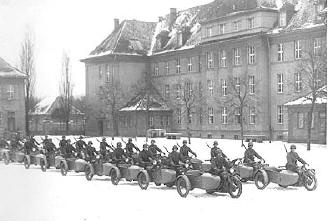 |
|
| |
On a snowy day, just the drivers turn
out with their motorcycle sets in this mid 1930s Kradschutzen scene.
Although not captioned, the photo is from an album that leads us to
believe the soldiers are from the 2 Krad.
--Stefanowicz |
|
Germany was burdened by a
crushing debt of war reparations, the global depression and the fight against
communists in the streets. The Brown Shirts brawled with fists and pistols
against every political party that opposed them; private right wing armies, the
Frei Korps, fought along the Polish border and in the main streets of Berlin.
Communists, trade unionists, Socialists and Social Democrats were viewed as dire
enemies. What was left of the German officer corps either began the process of
politicization and support of the growing Nazi party or retreated to the salons
to study tactics.
This between war period was a
dynamic time of growth in the theory and doctrine of future war fighting in
Germany. The old generals of trench warfare were in all but the most senior
levels either swept aside or marginalized while the " captains and colonels of
thought ", either still in the 100, 000 man Reichswehr or temporarily furloughed
from the military began with a blank piece of paper and a simple question, " how
to fight a war in Europe and never again be trapped in trench warfare? ".
| |
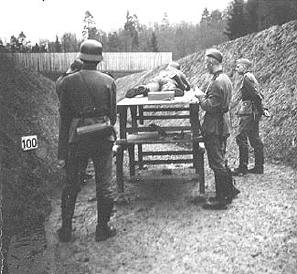 |
|
| |
This photo was taken at Bad Kissingen but shows a very typical rifle
marksmanship training scene from that period.
--Stefanowicz |
|
The revolutionary Blitzkrieg
tactic and everything that flowed from it, massed armor forces in rapid break
through and exploitation attack, close coordination of field artillery and
covering air forces, leadership and initiative pushed to the lowest possible
levels and the development of equipment to support this doctrine were key
features of German military development in the between war period. Equipment
development and unit training was conducted in secret and in foreign locations,
the Soviet Union an odd and ironic partner. With the rise of Hitler, the Germans
renounced almost all of the restrictions that had been placed at the end of WWI.
Keep troops in fast motion!
Everything was tried to increase infantry tempo. As late as the invasion of the
Soviet Union in 1941, certain German infantry battalions were equipped with
bicycles to increase their potential daily march rate. Colonel Student designed
the airborne forces, Colonel Rommel wrote the tactics books and General Guderian
studied armor and supporting forces. Truck carried infantry battalions were
designed into the Panzer divisions. Motorcycles, a familiar component of German
life and well established in the civilian manufacturing base, BMW and NSU, were
integrated into both the signal and headquarters units as couriers and the
combat units as part of the Schnell Truppen or fast troops.
| |
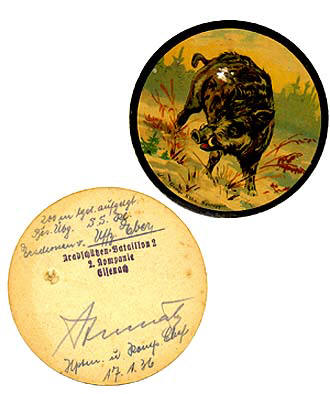 |
|
| |
... and here are some sample targets. The disk is shown both front and
back; this type of target was probably used for a good natured
shooting competition for prizes. The back of the target is stamped as
2 Kradschutzen Eisenach and is verified by both the training NCO and
the commander.
--Stefanowicz |
|
As the first three panzer
divisions were built in the mid 1930s, along with two regiments of tanks, each
would also have their own mobile infantry regiment consisting of two truck
mounted battalions and one Kradschutzen battalion - a fast moving yet heavily
armed motorcycle infantry unit. A simple unit numbering system was adopted for
the integrated infantry units; in Panzer Division# 2 for example, Schutzen
Regiment # 2 consisted of Abteilung I and II, the truck mounted battalions and
Kradschutzen Battalion 2, the motorcycle - rifle battalion.
In combat, cross attachment
between the armor and infantry battalions within the division was accomplished
by creating Kampfgruppe ( battle groups ) configured by the senior commander to
suit the mission and terrain. On other occasions battalion level units were
committed “ pure “ but had carefully trained to be mutually supporting. This
latter method of employment was the usual way the Kradschutzen expected to
fight.
| |
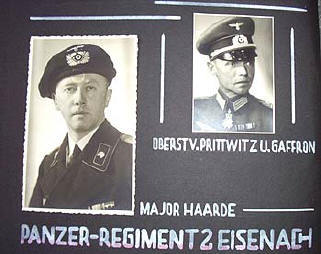 |
|
| |
Way over our spending limit, a sample page from a period photo album
showing 2 Panzer personalities while at Eisenach. The apparent overall
commander of troops, Colonel Prittwitz und Gaffron is to the right.
Note the black Panzer beret of the battalion commander to left.
--Franz Steinzer |
|
Motorcycle infantry battalions
were also found in the Lichte ( light ) divisions, SS divisions and Luftwaffe
ground combat units. Motorcycle companies were allocated to select infantry
divisions as both part of the fighting force and recon capability. Eventually,
the mobility of the motorcycle did not out weigh the lethality of the
battlefield and by 1942 - 1943, these units were integrated into the division
reconnaissance battalions. The truck mounted infantry battalions evolved into
Panzer Grenadier units once their transport up graded to the highly successful
series of ˝ track infantry carriers produced by German industry.
Kradschutzen Battalion 2
traces its roots to the " II Schwadron ( squadron ) des Reiter - Regiment 16 "
in the industrial town of Eisenach, about 40 kilometers east of Bad Hersfeld -
85 kilometers north of Bad Kissingen. The unit was redesignated as a
Kradschutzen Battalion in 1935 as equipment and tactics demanded that they drop
the old horse cavalry title. The unit was raised with men from the following
central German towns: Hofgeismar, Ansbach, Bamberg, Erfurt and Eisenach.
Troopers may recall these town names were cast in concrete as part of the
military coat of arms motifs over each barracks door at Manteuffel / Daley. In
one of the many interesting twists of fate that track this German unit, both
Ansbach and Bamberg became major US Army troop centers during the Cold War;
Soviet forces could be found in Erfurt and Eisenach would become a major East
German Army center.
| |
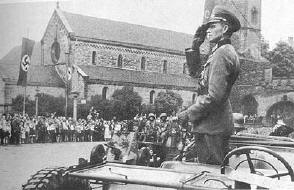 |
|
| |
The troops parade past Colonel Prittwitz as they depart Eisenach for
Bad Kissingen and Bamberg.
--Franz Steinzer |
|
This motorcycle battalion,
often abbreviated as Krad 2 or K2, was aligned with the newly built 2nd
Panzer Division and elsewhere in Germany, Kradschutzen battalions for the 1st
and 3rd Panzer Divisions were built respectively at Langensalza and
Freienwalde. All these units shared antecedent roots with cavalry - then
motorized cavalry battalions of the pre Hitler Reichswehr.
While much of the fine detail
is long lost, the story of the motorcycle infantry unit in Eisenach that would
then move to Bad Kissingen, can be partially pieced together from a number of
sources. This town had a long standing military tradition dating to before World
War I. The old, small barracks on the outskirts of town had been home to
Battalion # 2 of Infantry Regiment 94. In the early between wars period, this
building had a new tenant, the 2nd Squadron of Cavalry Regiment 16 as
it first became motorized. By the mid 1930s, a massive new barracks was planned
for the area and the men of the now designated Kradschutzen Battalion 2 moved
into temporary wooden buildings near their motor pool as the nearby construction
project got underway.
| |
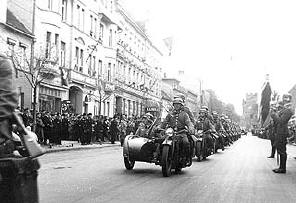 |
|
| |
Part of the formal departure parade as the 2 Krad moves on to a
temporary home in Coburg and then Bad Kissingen.
--Stefanowicz |
|
Once completed, this new
barracks, simply known as Panzer Kaserne, was designed as the home for the newly
built Panzer Regiment # 2, part of the 1st Panzer Division. The
division’s anti - tank battalion also soon moved to Eisneach. Colonel Prittwitz
und Gaffron was the senior Panzer commander at the barracks. An early hero of
the Reich, he was killed at Tobruck in 1941 commanding the 15th Panzer Division.
All of this construction and
the arrival of so many tanks was probably very interesting to the men of the 2
Krad as they went about their own daily training and maintenance routines.
Living in tar paper covered barracks buildings well below Wehrmacht standards,
they knew as early as 1935, that a new facility being built in Bad Kissingen was
their future home. As construction went forward in the Kurstadt and their
battalion commander, Colonel Apell monitored the progress, the motorcycle
infantry of the 2nd Panzer Division could only look on as the tankers
of Panzer Regiment # 2, dressed in their distinctive black uniforms, enjoyed the
new barracks, training buildings and mess halls.
| |
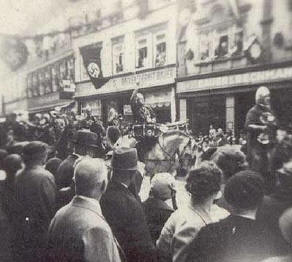 |
|
| |
A horse mounted military band, the
central figure is a drummer with kettle drums straddling the horse's
neck.
--Stefanowicz |
|
The final circumstances of the
motorcycle battalion departure from Eisenach are somewhat confused. One source
briefly states that the unit first moved to Coburg, about 40 kilometers east -
southeast of Kissingen. If this is accurate, it was only a brief stay. As many
units moved to new barracks locations throughout central Germany it may have
been that in the master schedule, Manteuffel Kaserne was slightly behind in
construction and the Kradschutzen needed to vacate Eisenach as another unit
arrived. Coburg, if used at all, may have been a convenient temporary home.
| |
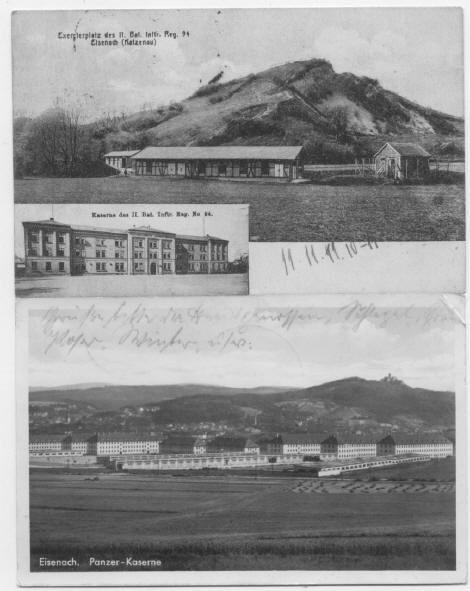 |
|
| |
Two postcards that tell much of the pre war story
of Eisenach. Top card shows the training area and old barracks building that was
the first home to the 2 Kradschutzen Battalion. Bottom card shows the extensive
new Panzer Kaserne that was built in the city in the mid 1930s. The 2 Krad moved
into temporary wooden barracks while their new home in Bad Kissingen was being
built. |
|
The documented welcoming date
of arrival for 2 Krad in Bad Kissingen is 1 June, 1937 although in reality, the
battalion had arrived with little fanfare some days earlier. Regardless of the
fine details, the men found Manteuffel Kaserne, not quite completed, was as new
and modern military facility as could be found in the steadily re - arming
Germany.
| |
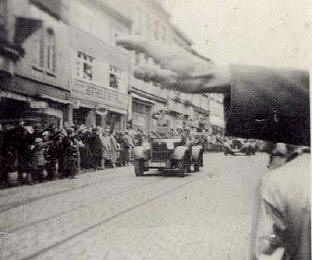 |
|
| |
A military parade in Eisenach, an
officer leads the way in a heavy field car.
--Stefanowicz |
|
| |
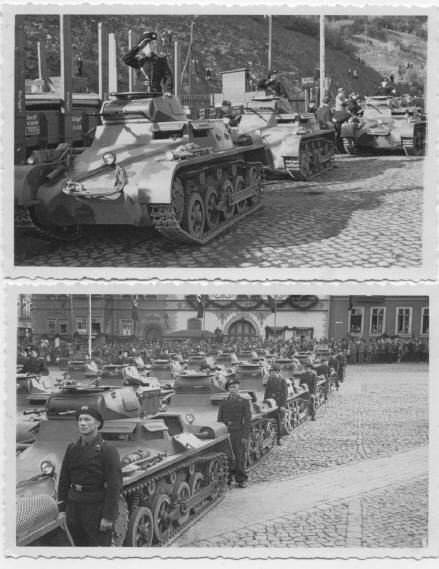
These unpublished fotos capture events
as a Regiment of the 1st Panzer Division moves into the new Panzer
Kaserne at Eisenach. Seen here, arrival at the rail head and parade in
the town square. |
|
| |
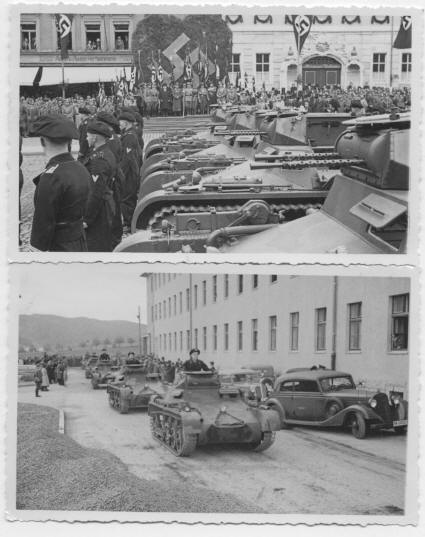
Various officials and senior officers
review the troops and then the Panzers make the final move to the new
barracks. |
|
On the day that also
commemorated German war dead from the First World War, the city turned out to
formally greet the battalion. The ceremonies included a mechanized march through
town, a formal parade in the Luitpold Park by the Saale River and speeches by
military and civilian dignitaries. As the long summer days of June in the Rhoen
region began, Krad 2 quickly settled into garrison life and the process of
integrating the next new “ class “ of draftees. Later, in the Fall of that year,
the men of 2 Krad invited the town to an open house at the barracks. Such was
the life and training of a Kradschutze mobile infantryman, move fast, be
flexible, always move fast and, as would echo through following decades as
uniforms and languages at the barracks changed, try and be good neighbors to the
local civilian population.
Revised December 2005
Return to History
Part I
|
|